20+ Sample Gym Membership Contracts
-

Gym Membership Agreement Sample
-

Membership Agreement Application Sample
-

Personal Training Service Agreement
-
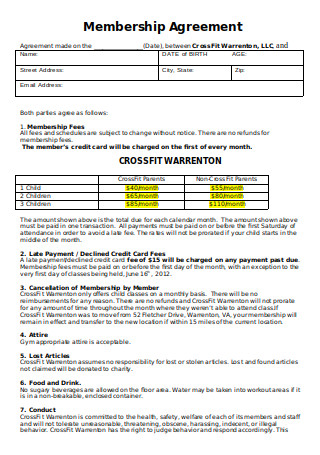
Membership Agreement
-

Fitness Membership Agreement
-

Fitness Membership Agreement Sample
-

Gym Signature of Agreement
-

Health Fitness Membership Agreement
-

Formal Fitness Membership Agreement
-

Corporate Gym Membership Contract
-

Membership Contract Form
-
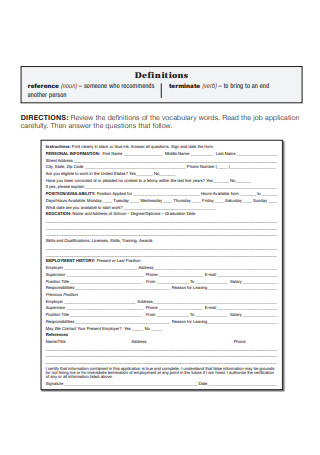
Gym Membership Contract
-
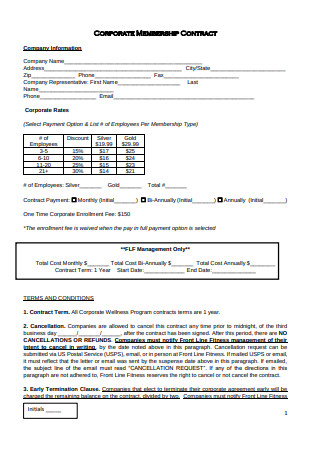
Corporate Membership Contract
-
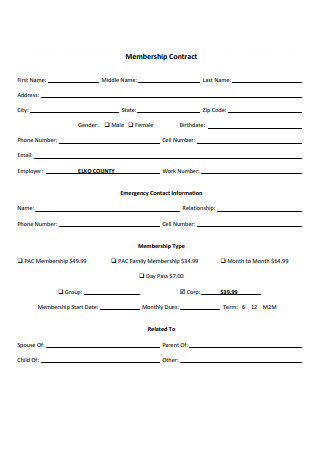
Printable Membership Contract Form
-

Simple Membership Contract
-

Gym Membership Contract Agreement
-
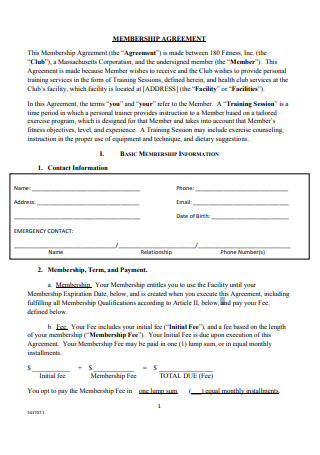
Simple Fitness Membership Agreement
-

Lifestyles Terms & Conditions Contract
-

Fitness Centre Membership Contract
-

Membership Agreement in PDF Format
-

Gym Membership Agreement Application
What Is a Gym Membership Contract?
Most private gyms allow new customers to sign a membership contract to take part in special programs offered by their facility. This documents the agreement between the business and its customers to summarize the expectations for both parties clearly and logically. The specifics of the arrangement would typically depend on the services offered by your business as well as the type of audience you expect to target. Restrictions, fees, obligations, privacy, and accountability claim exemptions are some of the most essential items in the contract that aim to protect you as an owner of the business. Creating the contract itself is not that difficult, as long as you are aware of what the agreement must cover.

The Benefits of a Gym Membership Contract
More and more people are beginning to realize the importance of an active lifestyle. Statista reports a total of 60.87 million memberships in U.S. fitness centers in 2017, proving the amount of money and effort that people are willing to sacrifice for their well-being. But as a fitness business owner, retention is one of the top concerns you’re likely to have in this industry. Even when you have new customers coming in regularly, maintaining a strong membership list is essential to keep your business running. One of the significant reasons why it’s vital to preserve your current members is that winning new members can cost six to seven times more than trying to retain current ones. There are two ways to grow your community while also keeping existing ones in the group; to make them happy and to bind them to a contract.
Allowing your customers to have a month-to-month membership at your gym can come as an advantage for both the business and its target market. For one, customers feel obliged to go to the gym on a regular basis because they are committed to a contract. Making it official will force people to get out of bed every morning to hit the gym through the cold months of the year. Developing a routine to work out regularly might be difficult at first, but they’ll eventually get used to it and feel enticed to renew their membership contract for another period. As for the business itself, contracts help anticipate the gym’s revenue for the coming months. It’s a great way to identify what you’ve been doing right or wrong with your sales and marketing strategies.
Ultimately, gym membership contracts give more importance to retention than sales. What makes this the good thing is that it encourages you, as the owner of the business, to work hard to keep members interested through the continuous maintenance of facilities. It also fosters excellent customer service and other activities to uphold your party’s end of the contract.

How to Create a Gym Membership Contract
If you’ve drafted a comprehensive contract before, you’d know how complicated it can get at some points in the process. Gym membership contracts are no different from the binding agreements that businesses from other industries use to ensure that their obligations are communicated to the opposite party. Although it’s best to have the contract created by someone with a legal standpoint, it won’t hurt to draft the essential elements of the agreement on your own.
Step 1: Leave Blanks for Member Information
Most membership contracts come in a form that customers can fill out with their personal information. This includes one’s name, date of birth, phone number, and email address. Any other pieces of information deemed relevant to your objective may be a requirement as well. Be sure to ask the customer for a valid ID so you can verify the information reflected in the document and ensure that the agreement remains enforceable.
Step 2: Define the Services Being Provided to Members
Spell out the specific services that members will receive once the membership contract is signed. An outline of one’s rights and responsibilities protected by the agreement will make your customers feel both accountable and valued as members of your fitness community.
Also, it’s crucial to indicate the costs to become a member and the fees necessary to maintain this status. You need to be explicit about the fees charged to a customer’s account in terms of when and why they occur. While you wouldn’t want to drive your customers away with a lengthy list of charges they are likely to spend under specific terms, it is your obligation to keep members thoroughly informed of what they are about to get themselves into. You must also have a legitimate reason as to why you are implementing these payment policies in the first place.
Step 3: Include Provisions that Protect Your Business
It may sound rather selfish at first, but keeping your business from going down under, must always be a priority. Not everything wrong that happens within your establishment is caused by your negligence. At certain times, freak accidents occur despite your efforts to maintain a safe and secure environment for all. To prevent this from turning into a legal problem against your business, it’s best to include a few provisions that cover possible liability concerns. This is one way to avoid lawsuits and other legal actions brought to the attention of the authorities despite your lack of involvement in the issue. It’s not your fault if the subject incurs injuries while working out. If your gym’s equipment are in working condition, it isn’t fair for a member to blame you for a circumstance you didn’t cause.
Step 4: Write a Privacy Policy
Let members know what you plan to do with the information provided in the contract. Although you’re likely to use one’s personal data for an internal business purpose, it won’t hurt to put a person’s mind at ease by letting them know that the terms of the contract will remain strictly confidential. You can also allow members to opt out of the possibility of their information being shared with third-party entities.
Step 5: Conclude the Agreement
Conclude your gym membership contract by requiring customers to sign and date the agreement at the bottom of the page. This shows that the customer has understood and accepted the terms of the contract for both parties. Then they can move forward to the next stage of the business relationship. It’s also a good idea to include your contact information at the end of the document so members can easily reach you for questions or concerns that need to be addressed.

The Dos and Don’ts of a Gym Membership Contract
Starting a business in the fitness industry isn’t as glamorous as these professional trainers make it seem. As if getting customers interested in what you have to offer isn’t stressful enough, you also have to worry about keeping your audience engaged for as long as you are in business. Gyms and fitness clubs often rely on memberships to keep operations at bay. The document helps govern the relationship between the two parties to ensure that the business gets paid for their programs and amenities and that members receive the services being promised in the arrangement. With that said, here are a few reminders to consider when creating a gym membership contract:
Dos
1. Do include a clear purpose.
The very beginning of the document should explain to readers what the contract is for. The entire scope of the contract shall fall within this purpose and go toward achieving it. This should clarify the parties’ intentions when they entered into the agreement in the event of a dispute. A detailed membership contract may either expand or narrow the purpose of the contract for a reader’s better understanding. By doing so, the concerned parties remain informed of what they are getting into before agreeing.
2. Do be reasonable.
This is a membership contract for a gym, not an employee non-compete agreement. Signees won’t have access to any sensitive information about your business, nor will they have the authority to make decisions that could change the course of your gym’s operations. While it’s obvious why the terms and conditions of the contract matter to you as an owner, you still need to be reasonable with the policies and restrictions that the contract covers. The contract must protect the best interests of both parties to ensure the practicality of the whole relationship. The last thing you would want to do is to intimidate your customers with a ten-page agreement.
3. Do specify consequences for rulebreakers.
Once a person signs your contract, they are immediately accountable for their own actions. Failure to pay the monthly fee is one offense you shouldn’t take lightly. You can either charge extra for those who miss their due date or give them a pass for the month in hopes that they could make up for their mistakes on the next cut-off date. But you need to be careful when implementing the latter, as people are bound to abuse your kindness to an unacceptable degree. Any damages to the property shall also hold the culprit responsible for the act. Remember to include a clause that specifies the possible reasons for termination, especially for major offenses.
4. Do define the terms and conditions of the agreement.
What are the people who sign your gym contract entitled to? In most cases, members are given the privilege to use most, if not all, gym facilities as they please. Members also have an obligation to fulfill their end of the agreement by meeting their monthly or annual dues, utilizing gym facilities with care, and respecting other members of the fitness center. Be sure to define these provisions succinctly in the contract for all parties to comprehend. Any violations caused or accusations held against the offender may be supported by these statements.
5. Do offer a free trial period before getting a person to sign.
This is a tricky one. Offering services that are free of charge will likely attract vultures who are only in it for the free ride. Many gyms and fitness centers offer free training sessions for a month to get people to enroll in their program. While it isn’t always sufficient, it’s better than getting a person to sign a membership contract on their first visit. This will only scare your customers away, particularly those who are hesitant to make a considerable commitment without enough time to ponder on it. Consider this as an opportunity for your business to make a good impression on potential members who are thinking twice about signing to your fitness program.
Don’ts
1. Don’t assume the other party interprets terms the way you do.
Another reason why you wouldn’t want to complicate things is to avoid possible misunderstandings. Be mindful of words with multiple meanings as they may change how readers interpret your statements. If there are doubts, reconstructing the sentence may be the most efficient solution. You have to consider what your target audience will think of your contact to determine whether it’s even worth the read.
2. Don’t ignore potential disputes.
While this may not be as common as it is in a corporate setting, it’s possible nonetheless. There are a lot of things that could go wrong when entering into an agreement with another party. Any acts that constitute a criminal offense may become the subject of a dispute. This can get ugly, especially if both parties fail to reach a settlement over the matter at hand. This is one of the many reasons why including dispute resolution provisions are recommendable. The provision shall lay out the steps that parties must take to resolve the issue and avoid legal battles in court. This should allow both parties to discuss the problem and come to a mutual agreement without the interference of court orders.
3. Don’t use complicated language.
Your market may consist of individuals from different age groups and social classes. Unlike a regular business contract, this type of agreement must be simplified to a particular level. There’s no point in filling your content with jargon that your audience will less likely understand. If you do, defining any technicalities in its proper context is essential to avoid confusion. It’s best to keep it straightforward by using plain language to clarify each term. Refrain from using overly long sentences as well, as this would only leave room for ambiguity and misinterpretation. The least you can do is to break sentences down into easily digestible ideas for better comprehension.
4. Review and revise the contract.
Drafting a contract can be a long, draining process to complete, which then makes it vulnerable to inaccuracies in its first draft. This is why it is essential to read over the contents of your gym membership contract for any inconsistencies that need revision. You can also consult a legal expert to determine whether the agreement is enforceable in accordance with your state laws. There may even come a time when previously agreed-to provisions need to be updated to address concerns raised only after initial negotiations. When this happens, any modifications to the contract should be applied immediately. Make sure to memorialize anything added or omitted to ensure that all parties are aware of these changes.
5. Don’t rely on a template to do all the work.
Even if you use a contract template to establish your membership agreement, it’s still necessary to adapt the document to your particular situation. The template will only serve as a guide as you go through the drafting process of your contract. Keep in mind that formal contracts are not meant to be one-size-fits-all types of agreements for you to execute right away, as every business has its own principles that it hopes to uphold. Thus, always remember to modify the document to meet your general policies and company standards before having it signed.
Much of your time and money in running a fitness center go into keeping your customers satisfied with your service. Customer retention is best garnered when you learn to prioritize the needs of your audience as promised in your gym membership contract. If either party breaks any of the rules and conditions stated, you can settle the breach according to what was agreed upon in the agreement. In the end, it is your obligation to make sure that gym contracts are thoroughly read and understood by customers before allowing them to sign.
